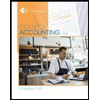
1.
Introduction:
Step-down method: The overhead costs of supporting incurred by the supporting department are allocated to other supporting departments and also the operating department based on the allocation base.
Allocation of the service department’s cost to the consuming department and the predetermined overhead rates in the operating department.
2.
Introduction:
Direct method: Under the direct method, the overhead costs incurred by the supporting department are directly allocated to the operating department.
Allocation of the service department’s cost to the consuming department using the direct method and the predetermined overhead rate.
3.
a.
Step-down method: The overhead costs of supporting incurred by the supporting department are allocated to other supporting departments and also the operating department based on the allocation base.
The amount of overhead cost for the job using overhead rates computed in parts 1 and 2.
3.
b.
Step-down method: The overhead costs of supporting incurred by the supporting department are allocated to other supporting departments and also the operating department based on the allocation base.
The reason the step-down method is a better base for computing the predetermined rates than the direct method.
Want to see the full answer?
Check out a sample textbook solution
Chapter 5 Solutions
FUND OF ACCT PRIN(LOOSE-LEAF)+ACCESS
- Please provide the accurate answer to this general accounting problem using valid techniques.arrow_forwardA company currently has a 42-day cash cycle. The firm adjusts its operations and makes the following changes: . • • It reduces its inventory period by 3 days It increases its receivables period by 5 days It increases its payables period by 4 days What will be the new length of the cash cycle after these changes?arrow_forwardI need help finding the accurate solution to this general accounting problem with valid methods.arrow_forward
- Can you explain this general accounting question using accurate calculation methods?arrow_forwardA company reports total liabilities of $3,500 and stockholders' equity of $2,400. What is the amount of total assets?arrow_forwardI am looking for the correct answer to this general accounting problem using valid accounting standards.arrow_forward
- Can you help me find the accurate solution to this financial accounting problem using valid principles?arrow_forwardA company reports the following figures for the • Net income: $280,000 . Preferred dividends: $30,000 year: • • Average total stockholders' equity: $2,100,000 Average common stockholders' equity: $1,300,000 (a) The return on stockholders' equity, and (b) The return on common stockholders' equity. (Round your answers to one decimal place.)arrow_forwardI don't need ai answer general accounting questionarrow_forward
 Intermediate Accounting: Reporting And AnalysisAccountingISBN:9781337788281Author:James M. Wahlen, Jefferson P. Jones, Donald PagachPublisher:Cengage Learning
Intermediate Accounting: Reporting And AnalysisAccountingISBN:9781337788281Author:James M. Wahlen, Jefferson P. Jones, Donald PagachPublisher:Cengage Learning College Accounting, Chapters 1-27AccountingISBN:9781337794756Author:HEINTZ, James A.Publisher:Cengage Learning,
College Accounting, Chapters 1-27AccountingISBN:9781337794756Author:HEINTZ, James A.Publisher:Cengage Learning, Financial And Managerial AccountingAccountingISBN:9781337902663Author:WARREN, Carl S.Publisher:Cengage Learning,
Financial And Managerial AccountingAccountingISBN:9781337902663Author:WARREN, Carl S.Publisher:Cengage Learning, Financial AccountingAccountingISBN:9781337272124Author:Carl Warren, James M. Reeve, Jonathan DuchacPublisher:Cengage Learning
Financial AccountingAccountingISBN:9781337272124Author:Carl Warren, James M. Reeve, Jonathan DuchacPublisher:Cengage Learning College Accounting, Chapters 1-27 (New in Account...AccountingISBN:9781305666160Author:James A. Heintz, Robert W. ParryPublisher:Cengage Learning
College Accounting, Chapters 1-27 (New in Account...AccountingISBN:9781305666160Author:James A. Heintz, Robert W. ParryPublisher:Cengage Learning Financial Accounting: The Impact on Decision Make...AccountingISBN:9781305654174Author:Gary A. Porter, Curtis L. NortonPublisher:Cengage Learning
Financial Accounting: The Impact on Decision Make...AccountingISBN:9781305654174Author:Gary A. Porter, Curtis L. NortonPublisher:Cengage Learning





